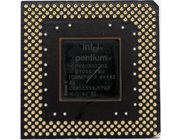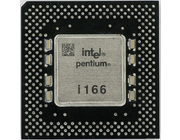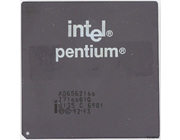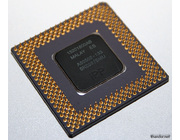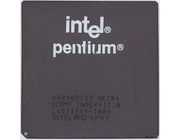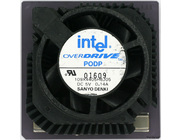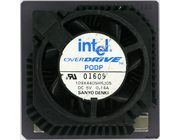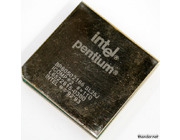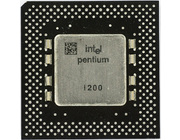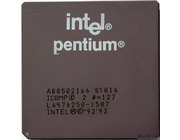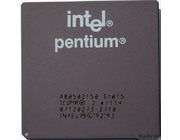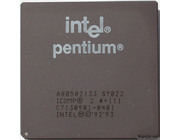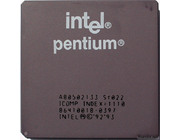I have two Pentium 200's that are identical except for it's production date. Usually I'll try to avoid getting too much of the same CPU's (i.e. same sSpec or revision) but in this case I found it interesting to have a CPU that is dated week 45 of 1996. The Pentium 200 was released in week 24 of 1996 and was the fastest CPU at the time.
In 1996 the slower Pentium's (75, 100, 120) were still popular as affordable choice. Even 486-class systems were still sold as budget system. It wasn't until 1997 when the Pentium MMX (166, 200MHz) became commonplace. > Read more
The near twin of this CPU. The only difference between the to is the ending of the serialnumber: 0628 instead of 0687. > Read more
A quite uncommon processor: an Overdrive for socket 4 systems. The first Pentium's used socket 4 and ran at 60MHz or 66MHz. Socket 4 had a short life-span because Intel quickly shifted to socket 5 which operated with a lower voltage (3,3V instead of 5V).
For those who invested a lot in the first socket 4, the so called 'upgrade-path' came to an end quickly as there we're no faster parts available than 66MHz. That was, until this Pentium Overdrive came into existence. Nevertheless it was an expensive upgrade but going from 60/66MHz to 120 or 133MHz (this Overdrive is also officially rated for 120MHz) was a nice boost back in '96. > Read more
First of all: this CPU is fake!
Some people take lower-end CPU's, modify (overclock) them to look like a faster model and sell them. This practice has been around for years and has been done quite recently as well. You can find fake 386 and 486 as well which often have something taped over that says it's a faster model. For example a 50MHz CPU is sold as 66MHz.
These gold CPU's are a bit different, though. They didn't modify the (ceramic) CPU but took a mobile CPU and build a gold (but actually good looking) cover around it. Everything is made very well and the CPU works well, too.
Modern examples of fake CPU's are the AMD Athlon XP. These CPU's don't have a CPU string so the name of the CPU (which you see in Windows or CPU-z) is generated by the BIOS. If you take a 2500+, tape over the OPN code so it will show 3200+, then people will configure it as a 3200+ (which has a faster FSB but the same multiplier) and the BIOS will show AMD Athlon XP 3200+. There you go: you made more than a 100$ profit.
How to recognize these fake CPU's? In this case it's pretty obvious because of the gold packaging. Sometimes it's difficult but look carefully. Often the font is a bit different or the position of the words doesn't match. Also check the OPN or sSpec code. Take a look at the SL25J sSpec code on this CPU which is from a Pentium 120! In some cases the production date doesn't appear to be valid; fakers seem to generate a random number but when you're into these number you can read the production date. Some CPU's are made after week 52/53 from a particular year which is not possible.
If you ever find one of these CPU's and want to open it (like I did) be careful! You can pop open the top with a screwdriver but be careful when cleaning the 'die' (core; the chip in the middle). It has very tiny connections/lines and if you move them they can break or short as soon as you power up the CPU. > Read more
The top-of-the-line Pentium processor. The only Pentiums that are faster are the Pentium MMX but they are not similar to the first kind of Pentium. I've never seen a Pentium 200MHz system running in real life as they were quite expensive back in the days this thing was new. By the time 166MHz and 200MHz parts became feasible to buy the Pentium MMX was widely available.
Because the Pentium MMX uses a lower voltages some older motherboards can not run the MMX processor. You have to use a classic Pentium instead and if you're looking to boost your system to the fastest Pentium the 166MHz and especially 200MHz are the way to go ![]() .
.
Also note that the Pentium 200 uses the new PPGA (Plastic Pin Grid Array) instead of CPGA which is made of ceramic. Most Pentium MMX CPU's use PPGA as well but there are some ceramic versions as well. > Read more
For about 6 months this was the fastest CPU around. After that the 200MHz Pentium made it's debut and took the lead. At the time the Pentium 166 became affordable Cyrix and AMD had their 166MHz parts available. In general they were as good as the Pentium for business/office applications. In case you needed FPU performance (floating point, like CAD/CAM or games) the Pentium was your choice. > Read more
The Pentium 150 wasn't sold much because it had a slower FSB compared to the Pentium 133 and thus was less efficient and most people went for a Pentium 166 instead if they wanted performance. See the benchmarks that show the performance of the Pentium 150. Especially games (MDK, Doom and Quake) run quite poor on this CPU. Office-like applications don't need a fast bus or fast access to a graphics card so for those applications this CPU runs just fine.
Basically the Pentium 150 is just like the Pentium 133 but then with a different FSB / multiplier configuration. > Read more
Same as this Pentium 133 except for the production date and the iComp index etched into the processor. This processor, which is about half a year newer then the other one, has the iComp2 index. iComp stands for Intel Comparative Microprocessor Performance. The first iComp was used on the 486SX25 and as processors got newer and faster there was the need for a new version of iComp, called iComp 2.0. This can be found on Pentium 120 or higher. > Read more
The Pentium 133 is the slowest Pentium that uses the P54CS-core. The P54CS is the successor of the P54CQS and is used in 133, 150, 166 and 200MHz (without MMX) models. > Read more
